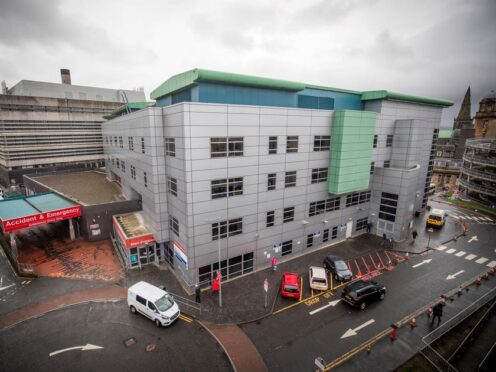
A healthcare watchdog warned of concerns for patient safety during an inspection of one of Scotland’s largest hospitals.
Healthcare Improvement Scotland (HIS) inspected the Glasgow Royal Infirmary emergency department on April 9 and found “significant patient safety concerns”.
The concerns sparked a second unannounced inspection on June 3-5 and this covered the whole hospital.
Donna Maclean, HIS chief inspector, said: “Our inspection of the emergency department at Glasgow Royal Infirmary identified patient safety concerns, and we returned to carry out a second unannounced hospital-wide inspection from June 3-5.
“We were assured that NHS Greater Glasgow and Clyde had responded promptly to the patient safety concerns highlighted during the initial inspection.”
No further details were provided on the nature of the safety concerns.
Ms Maclean added: “A full report, including the findings from the initial emergency department inspection, will be published in August 2024.”
The watchdog also carried out inspections of the emergency department at the Queen Elizabeth University Hospital (QEUH) in Glasgow on April 8 and a hospital-wide inspection of the Royal Alexandra Hospital (RAH) in Paisley on April 8-10.

Inspectors said in the morning of the visit to the QEUH the emergency department was “operating under significant pressure with an 11-hour wait for patients to be transferred to in-patient areas and a two-hour waiting time for first assessment by a clinician”.
No patients were being cared for in corridors – unlike in the RAH – but, in the afternoon, nine ambulances were waiting outside.
Inspectors reviewed incidents or adverse events in the three months prior to the inspection and found some relating to delays in triage and knock-on delays in patients having an initial electrocardiogram to measure heart activity.
Inspectors were told staff would be moved from other departments if triage delays increased; “see and treat” rooms were set up to cut delays in essential tests for patients in waiting rooms; and that, during the inspection, triage times were 15 minutes.
Inspectors said the QEUH emergency department was “calm and well led” adding that despite pressures “staff were focused on the provision of safe and compassionate care and patients were complimentary about their care and the staff providing it”.
Inspectors said RAH staff provided “safe and effective care in calm and well led areas”, with patients also “complimentary” about their care.
For those patients being cared for in the corridors, the hospital inspectors said they “appeared comfortable and had not been in the department for an extended period of time”.
Inspectors were told those waiting for a prolonged period would be transferred to a hospital bed for comfort but they did not see that happening during the inspection as the longest wait in the department then was seven hours.
Areas identified for improvement by HIS at both the RAH and QUEH included hand hygiene and safe storage of cleaning products.
An NHSGGC spokesperson said: “Following patient safety concerns being raised by HIS at the time of the emergency department inspection in April, a number of actions and improvements immediately took place assuring safe, quality care is in place and this remains our priority.
“A second visit was undertaken by HIS in early June and we look forward to receiving that report.”

Enjoy the convenience of having The Sunday Post delivered as a digital ePaper straight to your smartphone, tablet or computer.
Subscribe for only £5.49 a month and enjoy all the benefits of the printed paper as a digital replica.
Subscribe